Temple Architecture and Sculpture Chapter Notes | Fine Art for Class 11 - Humanities/Arts PDF Download
Introduction
- Most of the surviving art and architecture from Ancient and Medieval India is related to religion.
- Homes and their contents were generally constructed from materials like wood and clay, which have mostly decayed.
- This chapter presents various types of temples found in India, primarily focusing on Hindu temples, along with significant Buddhist and Jain temples.
- Religious shrines were built for many local cults in rural and forest areas, but unfortunately, these have also disappeared.
Early Temples
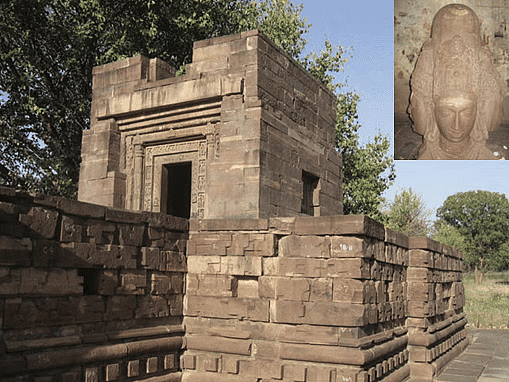 Shiva Temple
Shiva Temple
- The building of stupas continued, while Brahmanical temples and sculptures of gods began to be built.
- The myths found in the Puranas became part of the stories told in Brahmanical religion.
- Every temple featured a main image of a god.
- There were three types of temple shrines:
1. Sandhara
2. Nirandhara
3. Sarvatobhadra - Some significant temple locations from this time include Deogarh, Eran, Nachna-Kuthara, and Udaygiri.
The Basic Form of the Hindu Temple
- The basic form of the Hindu temple comprises the following: sanctum (garbhagriha), entrance to the temple (mandapa), mountain-like spire or vimana, and the vahan and standard pillar or dhvaj placed axially before the sanctum.
- Two broad orders of temples in the country are known—Nagara in the north and Dravida in the south.
- The Vesar style of temples as an independent style created through the selective mixing of the Nagara and Dravida orders is also mentioned.
- More surfaces were created for sculpture through additive geometry.
Sculpture, Iconography and Ornamentation
- The study of images of deities falls within a branch of art history called iconography, which consists of the identification of images based on certain symbols and mythologies associated with them.
- Every region and period produced its own distinct style of images with its regional variations in iconography.
- The temple is covered with elaborate sculptures and ornament that form a fundamental part of its conception.
- The placement of an image in a temple is carefully planned.
- Various forms or aspects of the main divinity are to be found on the outer walls of the sanctum.
- Subsidiary shrines around the main temple are dedicated to the family or incarnations of the main deity.
- Finally, various elements of ornamentation such as gavaksha, vyala/yali, kalpa-lata, amalaka, kalasha, etc. are used in distinct ways and places in a temple.
The Nagara or North Indian Temple Style
The Nagara or North Indian Temple Style
- The style of temple architecture popular in northern India is known as nagara.
- An entire temple is often built on a stone platform with steps leading up to it.
- Unlike in South India, it does not usually have elaborate boundary walls or gateways.
- Early temples had only one tower or shikhara, but later temples had several.
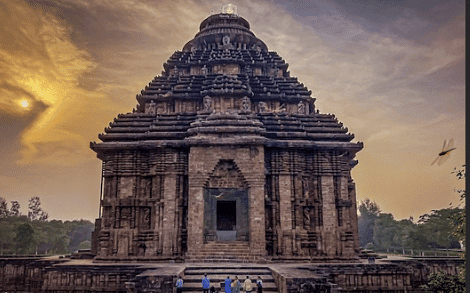 Sun Temple, Konark
Sun Temple, Konark
Types of Nagara Temples
A. Latina or Rekha-prasada type- A simple shikhara with a square base and walls that curve or slope inward to a point on top.
- The garbhagriha is located directly under the tallest tower.
- The most common type of shikhara.
B. Phamsana
- Broader and shorter than latina ones.
- Roofs are composed of several slabs that gently rise to a single point over the center of the building.
- The roofs slope upwards on a straight incline rather than curving inward.
- Often used for the mandapas while the main garbhagriha is housed in a latina building.
C. Valabhi
- Rectangular buildings with a roof that rises into a vaulted chamber.
- The edge of this vaulted chamber is rounded, like the bamboo or wooden wagons that would have been drawn by bullocks in ancient times.
- Also known as "wagon-vaulted buildings".
Central India
- Ancient temples in Uttar Pradesh, Madhya Pradesh, and Rajasthan share similarities.
- The most visible trait is that they are made of sandstone.
- The Gupta Period in Madhya Pradesh has some of the oldest surviving structural temples.
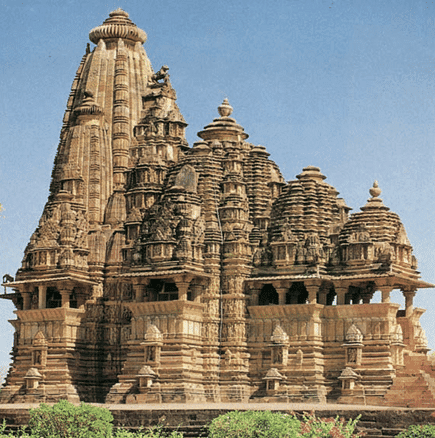 Vishwanatha Temple
Vishwanatha Temple
Gupta Period Temples in Madhya Pradesh
- The surviving temples are relatively modest-looking shrines with four pillars supporting a small mandapa and a garbhagriha.
- One temple is located in Udaigiri, part of a larger Hindu complex of cave shrines, and the other is at Sanchi, near the stupa.
- The temple at Sanchi is the first temple with a flat roof, indicating that similar developments were incorporated in the architecture of temples of both religions.
Deogarh Temple in Uttar Pradesh
- Deogarh temple was built in the early sixth century CE, about a hundred years after the temples in Sanchi and Udaigiri.
- It is a classic example of a late Gupta Period temple in the panchayatana style of architecture.
- The temple has a grand doorway with standing sculptures of female figures representing the Ganga and the Yamuna.
- The temple is west-facing and has three main reliefs of Vishnu on the walls.
Khajuraho Temples in Madhya Pradesh
- The temples were built by the Chandela Kings in the tenth century, about four hundred years after the temple at Deogarh.
- The Lakshmana temple of Khajuraho, dedicated to Vishnu, is a nagara temple with four smaller temples in the corners.
- The towers or shikharas rise high upward in a curved pyramidal fashion, ending in a horizontal fluted disc called an amalak topped with a kalash or vase.
- The Kandariya Mahadeo temple at Khajuraho is the epitome of temple architecture in Central India.
Erotic Sculptures in Khajuraho Temples
- Khajuraho's temples are known for their extensive erotic sculptures.
- The sculptures are highly stylized with typical features, and they are in almost full relief, cut away from the surrounding stone.
Yogini Temples
- The Chausanth Yogini temple is a temple of small, square shrines dedicated to goddesses associated with the rise of Tantric worship.
- Several such temples were dedicated to the cult of the yoginis across Madhya Pradesh, Odisha and even as far south as Tamil Nadu.
- They were built between the seventh and tenth centuries, but few have survived.
West India
West India, including Gujarat and Rajasthan, is known for its numerous temples built between the tenth and fifteenth centuries CE.
The stone used in building temples
- Sandstone is the most common stone used in temple construction.
- Grey to black basalt is also used in some temple sculptures.
- Manipulatable soft white marble is used in some Jain temples in Mount Abu and in the fifteenth-century temple at Ranakpur.
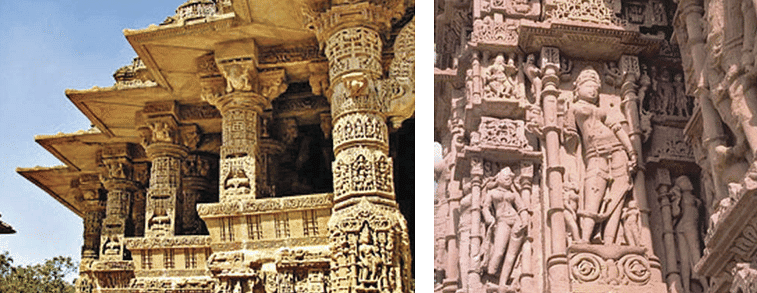 Sun Temple, Modhera, Gujarat
Sun Temple, Modhera, Gujarat
Art-historical sites
- Samlaji in Gujarat is an important site that shows a distinct style of sculpture that emerged from a mixing of earlier artistic traditions of the region and a post-Gupta style.
- A large number of sculptures made of grey schist have been found in the region, dating back to the sixth and eighth centuries CE.
Sun temple at Modhera
- Built in the early eleventh century by Raja Bhimdev I of the Solanki Dynasty in 1026.
- A massive rectangular stepped tank called the surya kund is in front of the temple.
- The tank has a hundred and eight miniature shrines carved in between the steps.
- A huge ornamental arch-torana leads to the sabha mandapa, which is open on all sides.
Influence of woodcarving tradition of Gujarat
- Evident in the lavish carving and sculpture work.
- Walls of the central small shrine in the Sun temple at Modhera are devoid of carving, as the temple faces the east, and the sun shines directly into this central shrine every year at the time of the equinoxes.
East India
- Eastern Indian temples include those found in the NorthEast, Bengal, and Odisha.
- Each of these three areas produced distinct types of temples.
- Terracotta was the main medium of construction in Bengal until the seventh century.
- A large number of sculptures have been found in Assam and Bengal that show the development of important regional schools in those regions.
Assam
- Gupta idiom was imported into Assam, and a post-Gupta style continued in the region well into the tenth century.
- By the twelfth to fourteenth centuries, a distinct regional style developed in Assam.
- The migration of the Tais from Upper Burma mixed with the dominant Pala style of Bengal and led to the creation of the Ahom style in and around Guwahati.
- Kamakhya temple, a Shakti Peeth, is dedicated to Goddess Kamakhya and was built in the seventeenth century.
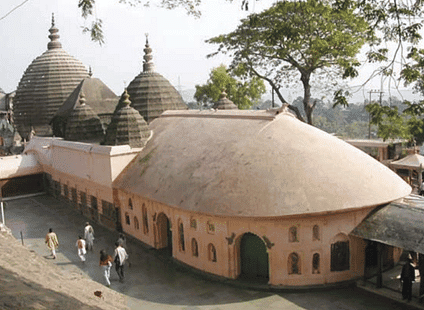 Kamakhya Temple
Kamakhya Temple
Bengal
- The Pala style of sculptures in Bengal (including Bangladesh) and Bihar is known as the style of the sculptures during the period between the ninth and eleventh centuries, while the style of those of the mid-eleventh to mid-thirteenth centuries is named after the Sena kings.
- Siddheshvara Mahadeva temple in Barakar in Burdwan District shows a tall curving shikhara crowned by a large amalaka and is an example of the early Pala style, similar to contemporaneous temples of Odisha.
- Many temples from the ninth to the twelfth century were located at Telkupi in Purulia District and were submerged when dams were built in the region, but several temples still survive in Purulia District.
- The shape of the curving or sloping side of the bamboo roof of a Bengali hut heavily influenced the earliest Bengal sultanate buildings at Gaur and Pandua, and this feature was eventually even adopted in Mughal buildings, known across North India as the Bangla roof.
- Terracotta brick temples were built across Bengal and Bangladesh in a unique style that had elements of local building techniques seen in bamboo huts combined with older forms reminiscent of the Pala period and with the forms of arches and domes taken from Islamic architecture, mostly dated to the seventeenth century.
Odisha
- The main architectural features of Odisha temples are classified into three orders: rekhapida, pidhadeul, and khakra.
- The temples of Odisha constitute a distinct sub-style within the nagara order, and the shikhara, called deul in Odisha, is vertical almost until the top when it suddenly curves sharply inwards.
- Deuls are preceded by mandapas called jagamohana in Odisha.
- The ground plan of the main temple is almost always square, which becomes circular in the upper reaches of its superstructure and makes the spire nearly cylindrical in appearance in its length.
- The exterior of the temples are lavishly carved, and their interiors are generally quite bare, and Odisha temples usually have boundary walls.
- The Sun temple at Konark was built in stone around 1240 and its shikhara was a colossal creation said to have reached 70m, which fell in the nineteenth century.
- The jagamohana has survived, which though no longer accessible is said to be the largest enclosed space in Hindu architecture.
- The Sun temple is set on a high base, its walls covered in extensive, detailed ornamental carving, and the whole temple thus comes to resemble a colossal processional chariot.
- The temple includes twelve pairs of enormous wheels sculpted with spokes and hubs, representing the chariot wheels of the Sun god who rides a chariot.
The Hills
- The hills of Kumaon, Garhwal, Himachal, and Kashmir had a unique form of architecture that developed from the intermingling of Buddhist and Hindu traditions.
- The hills also had their own tradition of wooden buildings with pitched roofs.
- At several places in the hills, the main garbhagriha and shikhara are made in a rekha-prasada or latina style, while the mandapa is of an older form of wooden architecture.
- The Karkota period of Kashmir is the most significant in terms of architecture, and one of the most important temples is Pandrethan, built during the eighth and ninth centuries.
- The architecture of Pandrethan temple is in keeping with the age-old Kashmiri tradition of wooden buildings, and due to the snowy conditions in Kashmir, the roof is peaked and slants slowly outward.
- The temples at Jageshwar near Almora, and Champavat near Pithoragarh, are classic examples of nagara architecture in the Kumaon region.
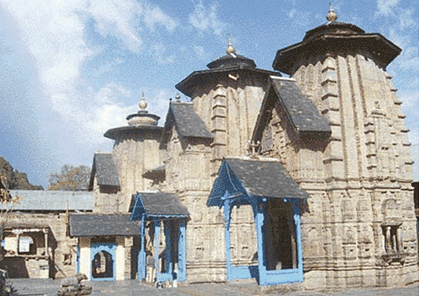
The Dravida or South Indian Temple Style
- The Dravida or South Indian temple style is different from the Nagara temple, enclosed within a compound wall.
- The main temple tower is called Vimana in Tamil Nadu and shaped like a stepped pyramid.
- The temple entrance has a gopuram, a central gateway.
Temple Components
- Shikhara is used only for the crowning element at the top of the temple, usually shaped like a small stupika or an octagonal cupola.
- Sculptures of fierce dvarapalas or door-keepers guarding the temple are generally found at the entrance to South Indian temples.
- The temple complex has a large water reservoir or temple tank.
- Subsidiary shrines are either incorporated within the main temple tower or located as separate small shrines beside the main temple.
- The South Indian idea of multiple shikharas rising together as a cluster was not popular, unlike the North Indian temples.
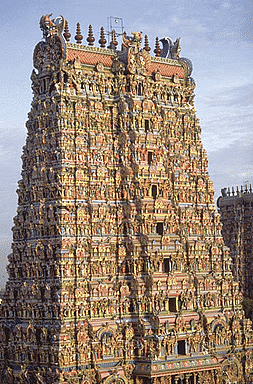 Meenakshi Temple, Madurai
Meenakshi Temple, Madurai
Temple Towns
- Temples became the focus of urban architecture in Kanchipuram, Thanjavur or Tanjore, Madurai, and Kumbakonam during the eighth to twelfth centuries.
- Temples became rich administrative centers that controlled vast areas of land.
- Pallavas were one of the ancient South Indian dynasties that were active in the Andhra region from the second century CE onwards and moved south to settle in Tamil Nadu.
Temple Shapes
- Dravida temples have five different shapes: square or caturasra, rectangular or shala or ayatasra, elliptical or gaja-prishta, circular or vritta, and octagonal or ashtasra.
- The plan of the temple and the shape of the vimana were conditioned by the iconographic nature of the consecrated deity.
- Several different shapes may be combined in specific periods and places to create their own unique style.
Pallavas
- Pallavas were mostly Shaivite but were also influenced by the long Buddhist history of the Deccan.
- Their early buildings were rock-cut, and later ones were structural.
- Narasimhavarman I, also known as Mamalla, inaugurated most of the building works at Mahabalipuram.
- The shore temple at Mahabalipuram was built later, probably in the reign of Narasimhavarman II, also known as Rajasimha.
- The shore temple at Mahabalipuram actually houses three shrines, two to Shiva and one to Vishnu.
Architecture in the Deccan
Many varied types of temple architecture were impacted by temples in North and South India in regions like Karnataka.
Vesara Style
- Origin: Emerged in the 7th century, combining North and South Indian styles.
- Features: Hybrid architecture is prevalent in Karnataka.
Rashtrakutas and Kailashnath Temple
- Era: Dominance began around 750 CE.
- Key Work: Kailashnath Temple at Ellora, entirely rock-cut, showcasing Dravida architecture with a detailed vimana and dynamic sculptures.
Western Chalukyas
- Establishment: Founded by Pulakesin I around 543 CE.
- Architecture: Both rock-cut and structural; notable sites include Ravana Phadi and Virupaksha Temples at Aihole and Pattadakal.
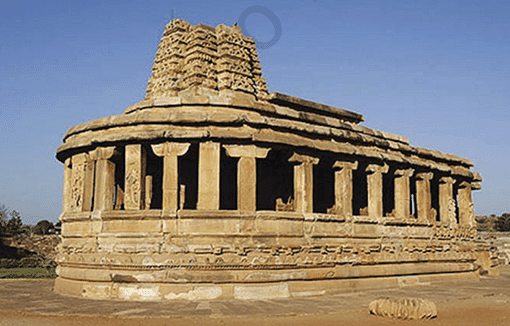 Durga Temple, Aihole
Durga Temple, Aihole
Hybridization in Chalukyan Architecture
- Notable Sites: Pattadakal and Aihole.
- Features: Combines Dravida and Nagara styles; Virupaksha Temple is exemplary for its ornate Dravida construction.
Hoysala Innovations
- Region: Centered in Mysore.
- Characteristic Style: Complex, stellate-plan temples built from soapstone allowing detailed carvings.
- Examples: Hoysaleshvara Temple at Halebid, notable for intricate sculptures.
Vijayanagara Empire
- Cultural Influence: Merged Dravida and Islamic architectural styles.
- Documentation: Well-documented by both local and foreign travelers, reflecting a period of cultural fusion and architectural innovation.
Buddhist and Jain Architectural Developments
Architectural and Religious Diversity (5th-14th Century)
- Integration of Religious Architectures: Sites like Ellora house Buddhist, Hindu, and Jain monuments. Other sites like Badami, Khajuraho, and Kannauj show remains of two religions side by side.
- Political Dynamics: Post-Gupta Empire (6th century CE), Bihar and Bengal (Magadha) remained unified, while Rajput principalities emerged in the west. The Palas rose to power in the 8th century, with Dharmapala consolidating a wealthy empire through agriculture and trade.
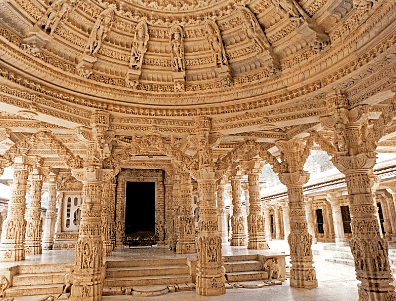 Dilwara Temple
Dilwara Temple
Buddhist Cultural Sites
- Bodhgaya: Key pilgrimage site where Siddhartha attained enlightenment. Features the Mahabodhi Temple, an architectural mix of nagara and dravida styles, reflecting historical renovations from Ashokan times to colonial reconstructions.
- Nalanda: Ancient monastic university, a significant center of Buddhist learning and art, influencing Buddhist art across Asia. Known for its high-quality sculpture work in stucco, stone, and bronze from the Gupta to the Pala periods.
Jain and Other Religious Sites
- Prominent Jain Sites: Include places like Ellora, Aihole, and the monumental statue of Gomateshwara in Karnataka. Jain temples noted for intricate marble interiors and extensive sculptural work, e.g., Mount Abu temples.
- Buddhist Influence Beyond India: Buddhist art and teachings from Nalanda and other sites influenced regions as far as China, Tibet, Southeast Asia, and Sri Lanka.
Materials and Artistic Techniques
- Variety of Materials: Stone, terracotta, and bronze were primary, with past use of perishable materials like wood and ivory. Many sculptures also featured paint, which has largely not survived.
- Artistic Tradition: The period was rich in sculptural and architectural innovation, with influences and syntheses from various regional styles contributing to diverse artistic expressions across religious sites.
|
10 videos|24 docs|16 tests
|
FAQs on Temple Architecture and Sculpture Chapter Notes - Fine Art for Class 11 - Humanities/Arts
| 1. What are the key characteristics of the Nagara or North Indian Temple Style in architecture? |  |
| 2. How does temple architecture in Central India differ from that in West and East India? |  |
| 3. What role does iconography play in temple sculpture and ornamentation? |  |
| 4. What are some prominent examples of Buddhist and Jain architectural developments in India? |  |
| 5. How does the ornamentation of temples reflect the socio-cultural context of their time? |  |
















